Effective Business Communication: Self-Reflection and Diagnostic Tools
VerifiedAdded on 2023/06/12
|17
|4804
|304
AI Summary
This essay discusses the importance of effective business communication in the workplace and how it affects interpersonal relationships and professional competence. It includes a self-reflection on communication skills and the use of five diagnostic tools to identify communication issues. The essay also provides a literature review on communication apprehension, public speaking, self-perceived communication competence, and tolerance for disagreement. Two recent professional interactions are analyzed to illustrate the importance of willingness to listen and tolerance for disagreement.
Contribute Materials
Your contribution can guide someone’s learning journey. Share your
documents today.
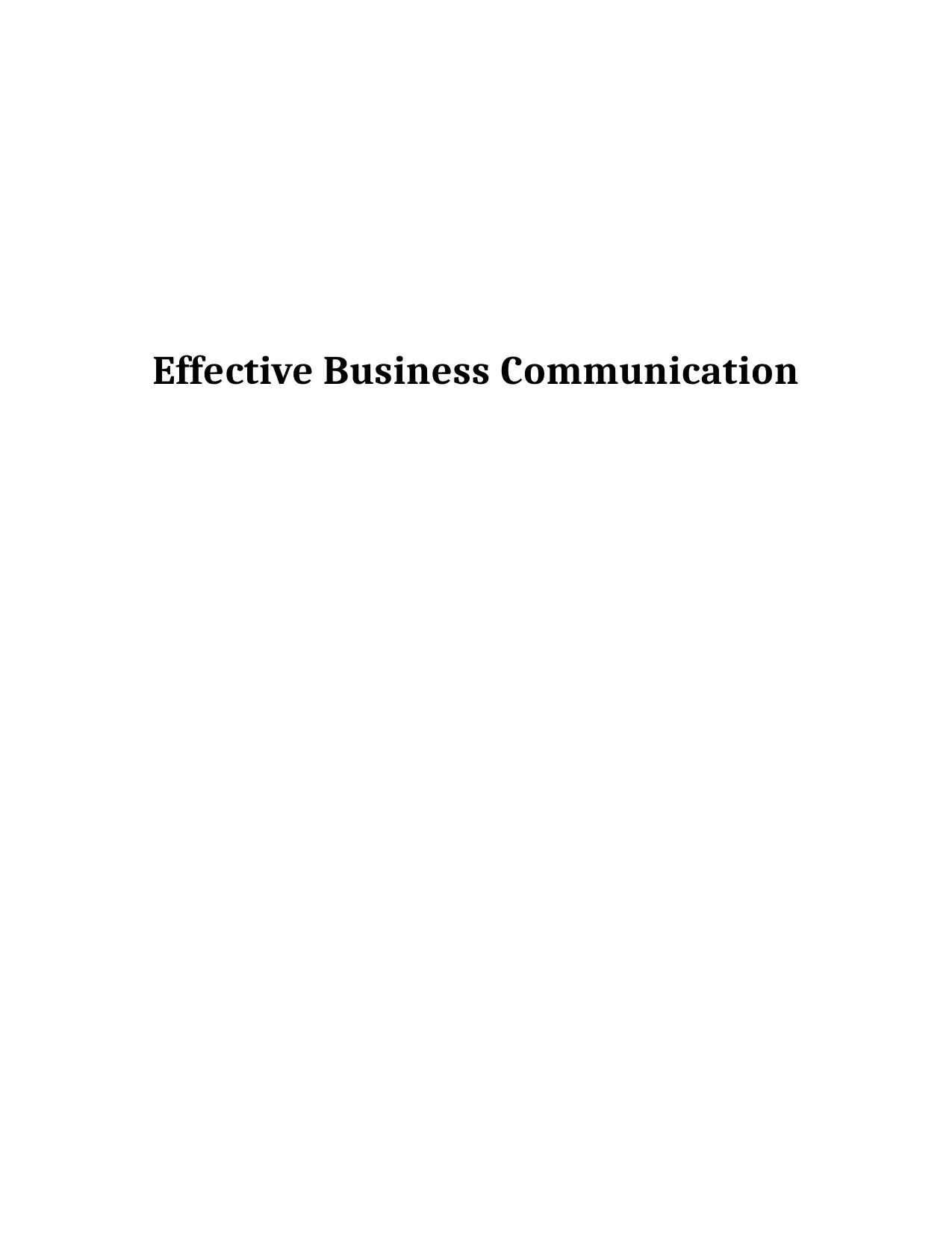
Effective Business Communication
Secure Best Marks with AI Grader
Need help grading? Try our AI Grader for instant feedback on your assignments.
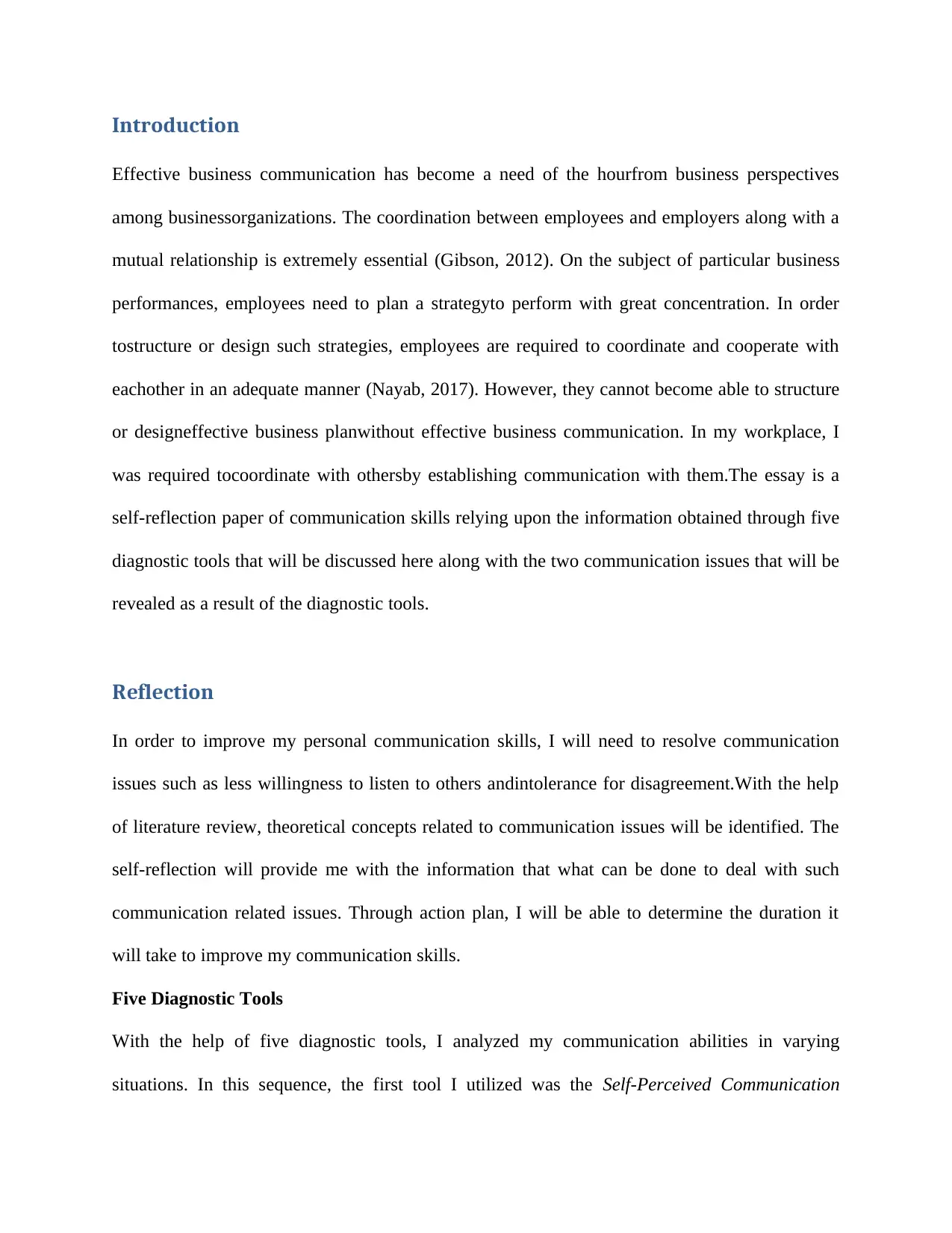
Introduction
Effective business communication has become a need of the hourfrom business perspectives
among businessorganizations. The coordination between employees and employers along with a
mutual relationship is extremely essential (Gibson, 2012). On the subject of particular business
performances, employees need to plan a strategyto perform with great concentration. In order
tostructure or design such strategies, employees are required to coordinate and cooperate with
eachother in an adequate manner (Nayab, 2017). However, they cannot become able to structure
or designeffective business planwithout effective business communication. In my workplace, I
was required tocoordinate with othersby establishing communication with them.The essay is a
self-reflection paper of communication skills relying upon the information obtained through five
diagnostic tools that will be discussed here along with the two communication issues that will be
revealed as a result of the diagnostic tools.
Reflection
In order to improve my personal communication skills, I will need to resolve communication
issues such as less willingness to listen to others andintolerance for disagreement.With the help
of literature review, theoretical concepts related to communication issues will be identified. The
self-reflection will provide me with the information that what can be done to deal with such
communication related issues. Through action plan, I will be able to determine the duration it
will take to improve my communication skills.
Five Diagnostic Tools
With the help of five diagnostic tools, I analyzed my communication abilities in varying
situations. In this sequence, the first tool I utilized was the Self-Perceived Communication
Effective business communication has become a need of the hourfrom business perspectives
among businessorganizations. The coordination between employees and employers along with a
mutual relationship is extremely essential (Gibson, 2012). On the subject of particular business
performances, employees need to plan a strategyto perform with great concentration. In order
tostructure or design such strategies, employees are required to coordinate and cooperate with
eachother in an adequate manner (Nayab, 2017). However, they cannot become able to structure
or designeffective business planwithout effective business communication. In my workplace, I
was required tocoordinate with othersby establishing communication with them.The essay is a
self-reflection paper of communication skills relying upon the information obtained through five
diagnostic tools that will be discussed here along with the two communication issues that will be
revealed as a result of the diagnostic tools.
Reflection
In order to improve my personal communication skills, I will need to resolve communication
issues such as less willingness to listen to others andintolerance for disagreement.With the help
of literature review, theoretical concepts related to communication issues will be identified. The
self-reflection will provide me with the information that what can be done to deal with such
communication related issues. Through action plan, I will be able to determine the duration it
will take to improve my communication skills.
Five Diagnostic Tools
With the help of five diagnostic tools, I analyzed my communication abilities in varying
situations. In this sequence, the first tool I utilized was the Self-Perceived Communication
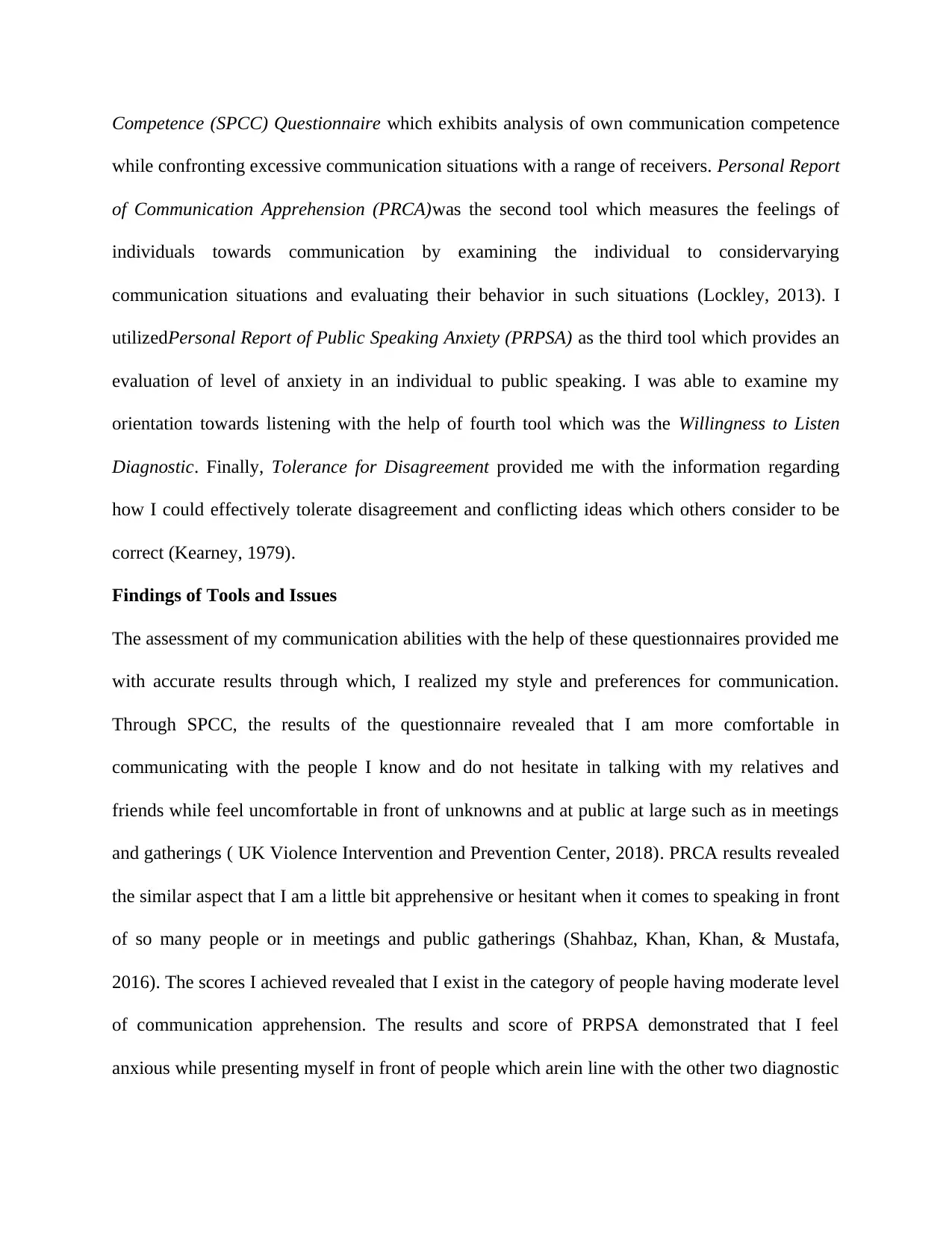
Competence (SPCC) Questionnaire which exhibits analysis of own communication competence
while confronting excessive communication situations with a range of receivers. Personal Report
of Communication Apprehension (PRCA)was the second tool which measures the feelings of
individuals towards communication by examining the individual to considervarying
communication situations and evaluating their behavior in such situations (Lockley, 2013). I
utilizedPersonal Report of Public Speaking Anxiety (PRPSA) as the third tool which provides an
evaluation of level of anxiety in an individual to public speaking. I was able to examine my
orientation towards listening with the help of fourth tool which was the Willingness to Listen
Diagnostic. Finally, Tolerance for Disagreement provided me with the information regarding
how I could effectively tolerate disagreement and conflicting ideas which others consider to be
correct (Kearney, 1979).
Findings of Tools and Issues
The assessment of my communication abilities with the help of these questionnaires provided me
with accurate results through which, I realized my style and preferences for communication.
Through SPCC, the results of the questionnaire revealed that I am more comfortable in
communicating with the people I know and do not hesitate in talking with my relatives and
friends while feel uncomfortable in front of unknowns and at public at large such as in meetings
and gatherings ( UK Violence Intervention and Prevention Center, 2018). PRCA results revealed
the similar aspect that I am a little bit apprehensive or hesitant when it comes to speaking in front
of so many people or in meetings and public gatherings (Shahbaz, Khan, Khan, & Mustafa,
2016). The scores I achieved revealed that I exist in the category of people having moderate level
of communication apprehension. The results and score of PRPSA demonstrated that I feel
anxious while presenting myself in front of people which arein line with the other two diagnostic
while confronting excessive communication situations with a range of receivers. Personal Report
of Communication Apprehension (PRCA)was the second tool which measures the feelings of
individuals towards communication by examining the individual to considervarying
communication situations and evaluating their behavior in such situations (Lockley, 2013). I
utilizedPersonal Report of Public Speaking Anxiety (PRPSA) as the third tool which provides an
evaluation of level of anxiety in an individual to public speaking. I was able to examine my
orientation towards listening with the help of fourth tool which was the Willingness to Listen
Diagnostic. Finally, Tolerance for Disagreement provided me with the information regarding
how I could effectively tolerate disagreement and conflicting ideas which others consider to be
correct (Kearney, 1979).
Findings of Tools and Issues
The assessment of my communication abilities with the help of these questionnaires provided me
with accurate results through which, I realized my style and preferences for communication.
Through SPCC, the results of the questionnaire revealed that I am more comfortable in
communicating with the people I know and do not hesitate in talking with my relatives and
friends while feel uncomfortable in front of unknowns and at public at large such as in meetings
and gatherings ( UK Violence Intervention and Prevention Center, 2018). PRCA results revealed
the similar aspect that I am a little bit apprehensive or hesitant when it comes to speaking in front
of so many people or in meetings and public gatherings (Shahbaz, Khan, Khan, & Mustafa,
2016). The scores I achieved revealed that I exist in the category of people having moderate level
of communication apprehension. The results and score of PRPSA demonstrated that I feel
anxious while presenting myself in front of people which arein line with the other two diagnostic
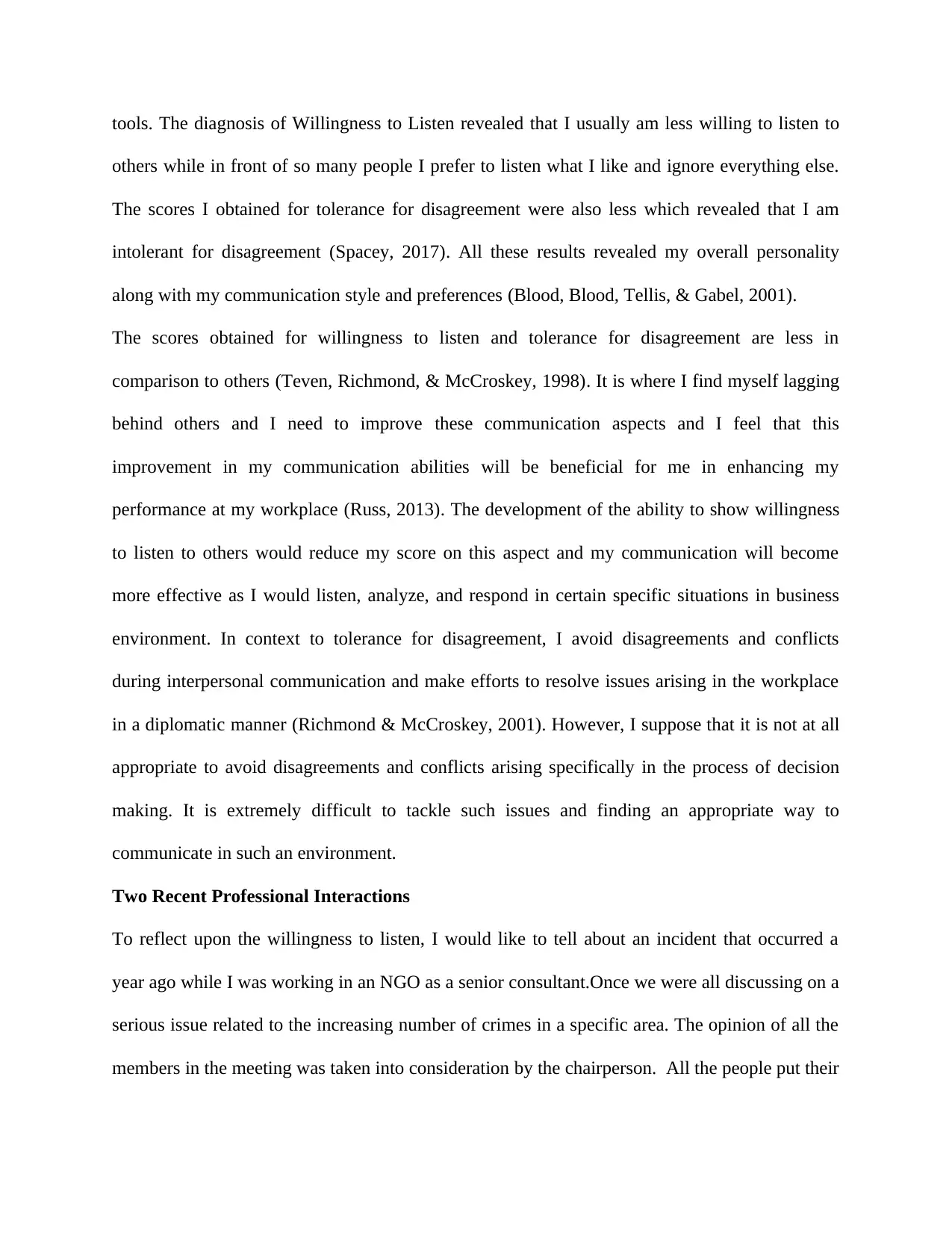
tools. The diagnosis of Willingness to Listen revealed that I usually am less willing to listen to
others while in front of so many people I prefer to listen what I like and ignore everything else.
The scores I obtained for tolerance for disagreement were also less which revealed that I am
intolerant for disagreement (Spacey, 2017). All these results revealed my overall personality
along with my communication style and preferences (Blood, Blood, Tellis, & Gabel, 2001).
The scores obtained for willingness to listen and tolerance for disagreement are less in
comparison to others (Teven, Richmond, & McCroskey, 1998). It is where I find myself lagging
behind others and I need to improve these communication aspects and I feel that this
improvement in my communication abilities will be beneficial for me in enhancing my
performance at my workplace (Russ, 2013). The development of the ability to show willingness
to listen to others would reduce my score on this aspect and my communication will become
more effective as I would listen, analyze, and respond in certain specific situations in business
environment. In context to tolerance for disagreement, I avoid disagreements and conflicts
during interpersonal communication and make efforts to resolve issues arising in the workplace
in a diplomatic manner (Richmond & McCroskey, 2001). However, I suppose that it is not at all
appropriate to avoid disagreements and conflicts arising specifically in the process of decision
making. It is extremely difficult to tackle such issues and finding an appropriate way to
communicate in such an environment.
Two Recent Professional Interactions
To reflect upon the willingness to listen, I would like to tell about an incident that occurred a
year ago while I was working in an NGO as a senior consultant.Once we were all discussing on a
serious issue related to the increasing number of crimes in a specific area. The opinion of all the
members in the meeting was taken into consideration by the chairperson. All the people put their
others while in front of so many people I prefer to listen what I like and ignore everything else.
The scores I obtained for tolerance for disagreement were also less which revealed that I am
intolerant for disagreement (Spacey, 2017). All these results revealed my overall personality
along with my communication style and preferences (Blood, Blood, Tellis, & Gabel, 2001).
The scores obtained for willingness to listen and tolerance for disagreement are less in
comparison to others (Teven, Richmond, & McCroskey, 1998). It is where I find myself lagging
behind others and I need to improve these communication aspects and I feel that this
improvement in my communication abilities will be beneficial for me in enhancing my
performance at my workplace (Russ, 2013). The development of the ability to show willingness
to listen to others would reduce my score on this aspect and my communication will become
more effective as I would listen, analyze, and respond in certain specific situations in business
environment. In context to tolerance for disagreement, I avoid disagreements and conflicts
during interpersonal communication and make efforts to resolve issues arising in the workplace
in a diplomatic manner (Richmond & McCroskey, 2001). However, I suppose that it is not at all
appropriate to avoid disagreements and conflicts arising specifically in the process of decision
making. It is extremely difficult to tackle such issues and finding an appropriate way to
communicate in such an environment.
Two Recent Professional Interactions
To reflect upon the willingness to listen, I would like to tell about an incident that occurred a
year ago while I was working in an NGO as a senior consultant.Once we were all discussing on a
serious issue related to the increasing number of crimes in a specific area. The opinion of all the
members in the meeting was taken into consideration by the chairperson. All the people put their
Secure Best Marks with AI Grader
Need help grading? Try our AI Grader for instant feedback on your assignments.
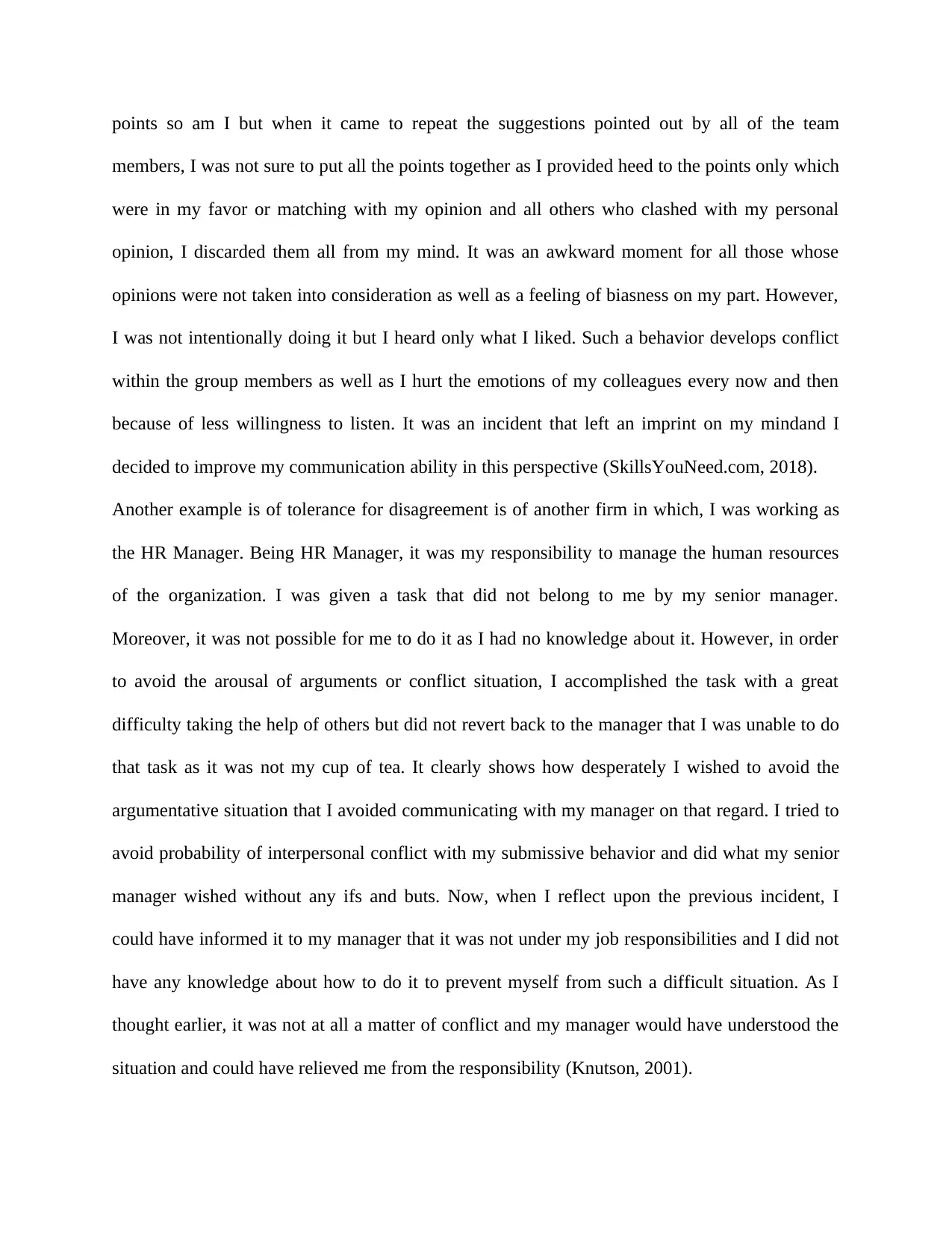
points so am I but when it came to repeat the suggestions pointed out by all of the team
members, I was not sure to put all the points together as I provided heed to the points only which
were in my favor or matching with my opinion and all others who clashed with my personal
opinion, I discarded them all from my mind. It was an awkward moment for all those whose
opinions were not taken into consideration as well as a feeling of biasness on my part. However,
I was not intentionally doing it but I heard only what I liked. Such a behavior develops conflict
within the group members as well as I hurt the emotions of my colleagues every now and then
because of less willingness to listen. It was an incident that left an imprint on my mindand I
decided to improve my communication ability in this perspective (SkillsYouNeed.com, 2018).
Another example is of tolerance for disagreement is of another firm in which, I was working as
the HR Manager. Being HR Manager, it was my responsibility to manage the human resources
of the organization. I was given a task that did not belong to me by my senior manager.
Moreover, it was not possible for me to do it as I had no knowledge about it. However, in order
to avoid the arousal of arguments or conflict situation, I accomplished the task with a great
difficulty taking the help of others but did not revert back to the manager that I was unable to do
that task as it was not my cup of tea. It clearly shows how desperately I wished to avoid the
argumentative situation that I avoided communicating with my manager on that regard. I tried to
avoid probability of interpersonal conflict with my submissive behavior and did what my senior
manager wished without any ifs and buts. Now, when I reflect upon the previous incident, I
could have informed it to my manager that it was not under my job responsibilities and I did not
have any knowledge about how to do it to prevent myself from such a difficult situation. As I
thought earlier, it was not at all a matter of conflict and my manager would have understood the
situation and could have relieved me from the responsibility (Knutson, 2001).
members, I was not sure to put all the points together as I provided heed to the points only which
were in my favor or matching with my opinion and all others who clashed with my personal
opinion, I discarded them all from my mind. It was an awkward moment for all those whose
opinions were not taken into consideration as well as a feeling of biasness on my part. However,
I was not intentionally doing it but I heard only what I liked. Such a behavior develops conflict
within the group members as well as I hurt the emotions of my colleagues every now and then
because of less willingness to listen. It was an incident that left an imprint on my mindand I
decided to improve my communication ability in this perspective (SkillsYouNeed.com, 2018).
Another example is of tolerance for disagreement is of another firm in which, I was working as
the HR Manager. Being HR Manager, it was my responsibility to manage the human resources
of the organization. I was given a task that did not belong to me by my senior manager.
Moreover, it was not possible for me to do it as I had no knowledge about it. However, in order
to avoid the arousal of arguments or conflict situation, I accomplished the task with a great
difficulty taking the help of others but did not revert back to the manager that I was unable to do
that task as it was not my cup of tea. It clearly shows how desperately I wished to avoid the
argumentative situation that I avoided communicating with my manager on that regard. I tried to
avoid probability of interpersonal conflict with my submissive behavior and did what my senior
manager wished without any ifs and buts. Now, when I reflect upon the previous incident, I
could have informed it to my manager that it was not under my job responsibilities and I did not
have any knowledge about how to do it to prevent myself from such a difficult situation. As I
thought earlier, it was not at all a matter of conflict and my manager would have understood the
situation and could have relieved me from the responsibility (Knutson, 2001).
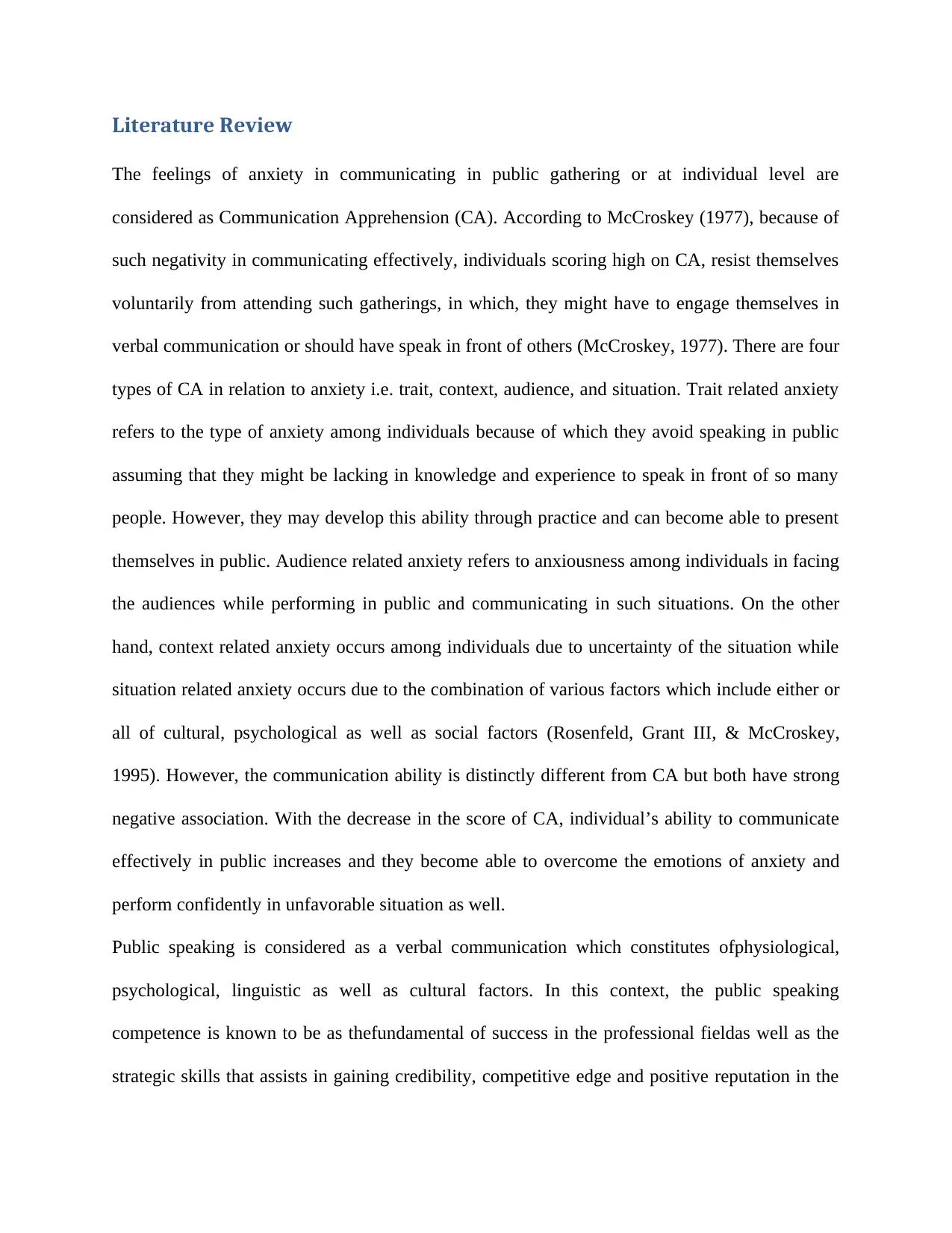
Literature Review
The feelings of anxiety in communicating in public gathering or at individual level are
considered as Communication Apprehension (CA). According to McCroskey (1977), because of
such negativity in communicating effectively, individuals scoring high on CA, resist themselves
voluntarily from attending such gatherings, in which, they might have to engage themselves in
verbal communication or should have speak in front of others (McCroskey, 1977). There are four
types of CA in relation to anxiety i.e. trait, context, audience, and situation. Trait related anxiety
refers to the type of anxiety among individuals because of which they avoid speaking in public
assuming that they might be lacking in knowledge and experience to speak in front of so many
people. However, they may develop this ability through practice and can become able to present
themselves in public. Audience related anxiety refers to anxiousness among individuals in facing
the audiences while performing in public and communicating in such situations. On the other
hand, context related anxiety occurs among individuals due to uncertainty of the situation while
situation related anxiety occurs due to the combination of various factors which include either or
all of cultural, psychological as well as social factors (Rosenfeld, Grant III, & McCroskey,
1995). However, the communication ability is distinctly different from CA but both have strong
negative association. With the decrease in the score of CA, individual’s ability to communicate
effectively in public increases and they become able to overcome the emotions of anxiety and
perform confidently in unfavorable situation as well.
Public speaking is considered as a verbal communication which constitutes ofphysiological,
psychological, linguistic as well as cultural factors. In this context, the public speaking
competence is known to be as thefundamental of success in the professional fieldas well as the
strategic skills that assists in gaining credibility, competitive edge and positive reputation in the
The feelings of anxiety in communicating in public gathering or at individual level are
considered as Communication Apprehension (CA). According to McCroskey (1977), because of
such negativity in communicating effectively, individuals scoring high on CA, resist themselves
voluntarily from attending such gatherings, in which, they might have to engage themselves in
verbal communication or should have speak in front of others (McCroskey, 1977). There are four
types of CA in relation to anxiety i.e. trait, context, audience, and situation. Trait related anxiety
refers to the type of anxiety among individuals because of which they avoid speaking in public
assuming that they might be lacking in knowledge and experience to speak in front of so many
people. However, they may develop this ability through practice and can become able to present
themselves in public. Audience related anxiety refers to anxiousness among individuals in facing
the audiences while performing in public and communicating in such situations. On the other
hand, context related anxiety occurs among individuals due to uncertainty of the situation while
situation related anxiety occurs due to the combination of various factors which include either or
all of cultural, psychological as well as social factors (Rosenfeld, Grant III, & McCroskey,
1995). However, the communication ability is distinctly different from CA but both have strong
negative association. With the decrease in the score of CA, individual’s ability to communicate
effectively in public increases and they become able to overcome the emotions of anxiety and
perform confidently in unfavorable situation as well.
Public speaking is considered as a verbal communication which constitutes ofphysiological,
psychological, linguistic as well as cultural factors. In this context, the public speaking
competence is known to be as thefundamental of success in the professional fieldas well as the
strategic skills that assists in gaining credibility, competitive edge and positive reputation in the

organizational environment. The research conducted by Marinho, Medeiros, Gama, and Teixeira
(2018) that several students possess fear of public speaking and majority of the students pursue
certain specific types of training programs in order to improve the public speaking. The research
also revealed that females in particular, do not prefer to participate in the public speaking and
majority of female students have the anxiety or fear of public speaking which becomes a barrier
in the process of communication (Marinho, Medeiros, Gama, & Teixeira, 2016).
Taking into consideration, the self-perceived communication, the opinion of Croucher, Rahmani,
Sakkinen, and Hample (2016) is that individuals make choices on the basis of their perceived
communication competence; however, it is prejudiced by their fear or willingness regarding
communication. The competency in communication varies with varying cultures as well as
depends upon belief of individuals on their ability to communicate in an adequate manner.
McCroskey & McCroskey (1988) provided SPCC instrument, which is a 12-item scale to
measure SPCC. It has also been found that there is a strong positive correlation between SPCC
and Willingness to Communicate, while strong negative correlation between SPCC and
Communication Apprehension (McCroskey & McCroskey, 1988).
The development of competency in public speaking is a prerequisite in business environment. In
order to be successful in professional life as well as to establish creditability and to communicate
fluently in public, the competence in public speaking is essential. In organizational
establishment, the level of CA determines the interpersonal workplace relationships and
effectiveness of individual as a performer. It has been found that individuals with prominent
level of CA are less probably includes others in the process of decision making. In addition, they
do not prefer to conduct collective communication with their subordinates (Shodganga , 2010).
Thus, communication apprehension influences the actions of the individuals to a greater extent
(2018) that several students possess fear of public speaking and majority of the students pursue
certain specific types of training programs in order to improve the public speaking. The research
also revealed that females in particular, do not prefer to participate in the public speaking and
majority of female students have the anxiety or fear of public speaking which becomes a barrier
in the process of communication (Marinho, Medeiros, Gama, & Teixeira, 2016).
Taking into consideration, the self-perceived communication, the opinion of Croucher, Rahmani,
Sakkinen, and Hample (2016) is that individuals make choices on the basis of their perceived
communication competence; however, it is prejudiced by their fear or willingness regarding
communication. The competency in communication varies with varying cultures as well as
depends upon belief of individuals on their ability to communicate in an adequate manner.
McCroskey & McCroskey (1988) provided SPCC instrument, which is a 12-item scale to
measure SPCC. It has also been found that there is a strong positive correlation between SPCC
and Willingness to Communicate, while strong negative correlation between SPCC and
Communication Apprehension (McCroskey & McCroskey, 1988).
The development of competency in public speaking is a prerequisite in business environment. In
order to be successful in professional life as well as to establish creditability and to communicate
fluently in public, the competence in public speaking is essential. In organizational
establishment, the level of CA determines the interpersonal workplace relationships and
effectiveness of individual as a performer. It has been found that individuals with prominent
level of CA are less probably includes others in the process of decision making. In addition, they
do not prefer to conduct collective communication with their subordinates (Shodganga , 2010).
Thus, communication apprehension influences the actions of the individuals to a greater extent
Paraphrase This Document
Need a fresh take? Get an instant paraphrase of this document with our AI Paraphraser
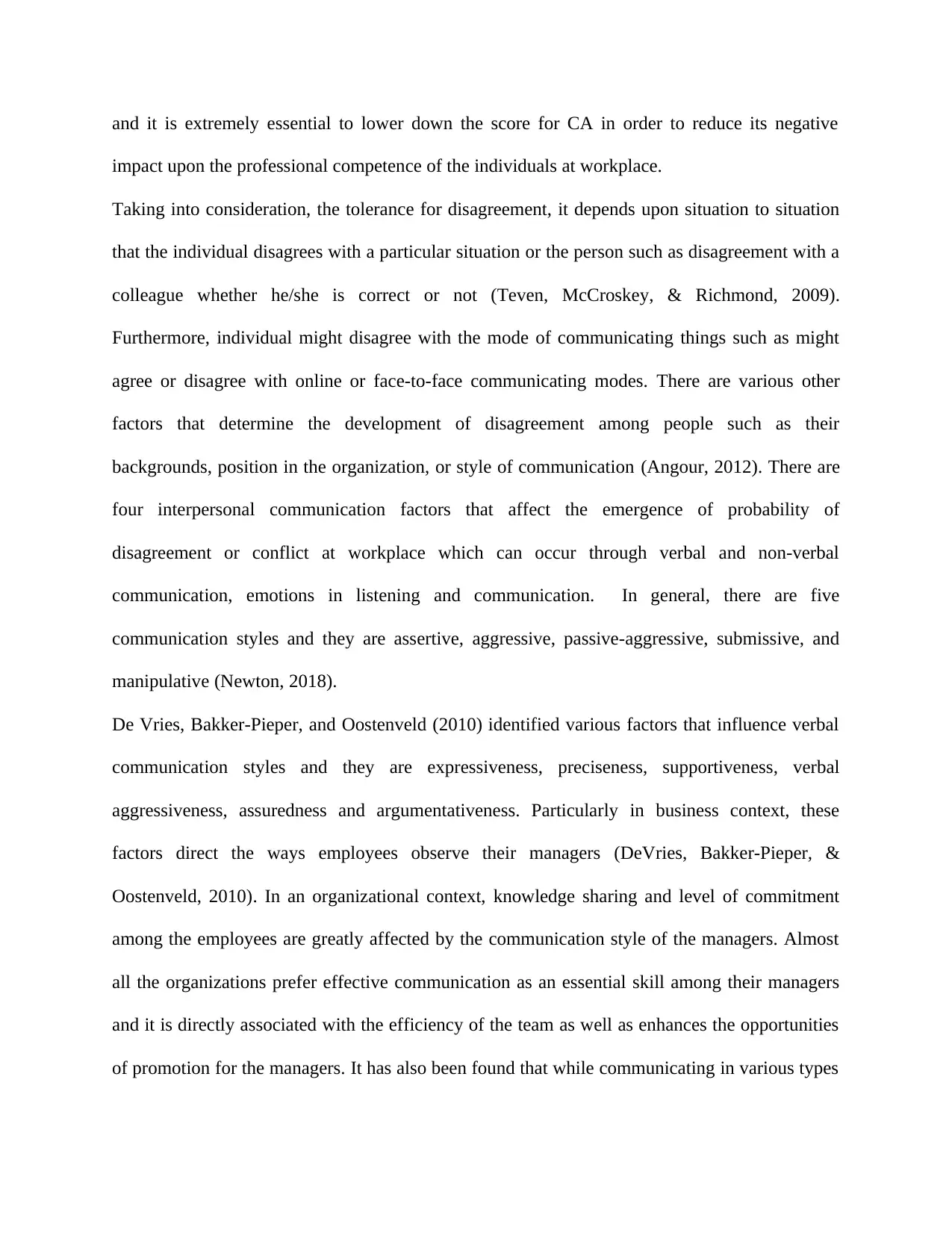
and it is extremely essential to lower down the score for CA in order to reduce its negative
impact upon the professional competence of the individuals at workplace.
Taking into consideration, the tolerance for disagreement, it depends upon situation to situation
that the individual disagrees with a particular situation or the person such as disagreement with a
colleague whether he/she is correct or not (Teven, McCroskey, & Richmond, 2009).
Furthermore, individual might disagree with the mode of communicating things such as might
agree or disagree with online or face-to-face communicating modes. There are various other
factors that determine the development of disagreement among people such as their
backgrounds, position in the organization, or style of communication (Angour, 2012). There are
four interpersonal communication factors that affect the emergence of probability of
disagreement or conflict at workplace which can occur through verbal and non-verbal
communication, emotions in listening and communication. In general, there are five
communication styles and they are assertive, aggressive, passive-aggressive, submissive, and
manipulative (Newton, 2018).
De Vries, Bakker-Pieper, and Oostenveld (2010) identified various factors that influence verbal
communication styles and they are expressiveness, preciseness, supportiveness, verbal
aggressiveness, assuredness and argumentativeness. Particularly in business context, these
factors direct the ways employees observe their managers (DeVries, Bakker-Pieper, &
Oostenveld, 2010). In an organizational context, knowledge sharing and level of commitment
among the employees are greatly affected by the communication style of the managers. Almost
all the organizations prefer effective communication as an essential skill among their managers
and it is directly associated with the efficiency of the team as well as enhances the opportunities
of promotion for the managers. It has also been found that while communicating in various types
impact upon the professional competence of the individuals at workplace.
Taking into consideration, the tolerance for disagreement, it depends upon situation to situation
that the individual disagrees with a particular situation or the person such as disagreement with a
colleague whether he/she is correct or not (Teven, McCroskey, & Richmond, 2009).
Furthermore, individual might disagree with the mode of communicating things such as might
agree or disagree with online or face-to-face communicating modes. There are various other
factors that determine the development of disagreement among people such as their
backgrounds, position in the organization, or style of communication (Angour, 2012). There are
four interpersonal communication factors that affect the emergence of probability of
disagreement or conflict at workplace which can occur through verbal and non-verbal
communication, emotions in listening and communication. In general, there are five
communication styles and they are assertive, aggressive, passive-aggressive, submissive, and
manipulative (Newton, 2018).
De Vries, Bakker-Pieper, and Oostenveld (2010) identified various factors that influence verbal
communication styles and they are expressiveness, preciseness, supportiveness, verbal
aggressiveness, assuredness and argumentativeness. Particularly in business context, these
factors direct the ways employees observe their managers (DeVries, Bakker-Pieper, &
Oostenveld, 2010). In an organizational context, knowledge sharing and level of commitment
among the employees are greatly affected by the communication style of the managers. Almost
all the organizations prefer effective communication as an essential skill among their managers
and it is directly associated with the efficiency of the team as well as enhances the opportunities
of promotion for the managers. It has also been found that while communicating in various types
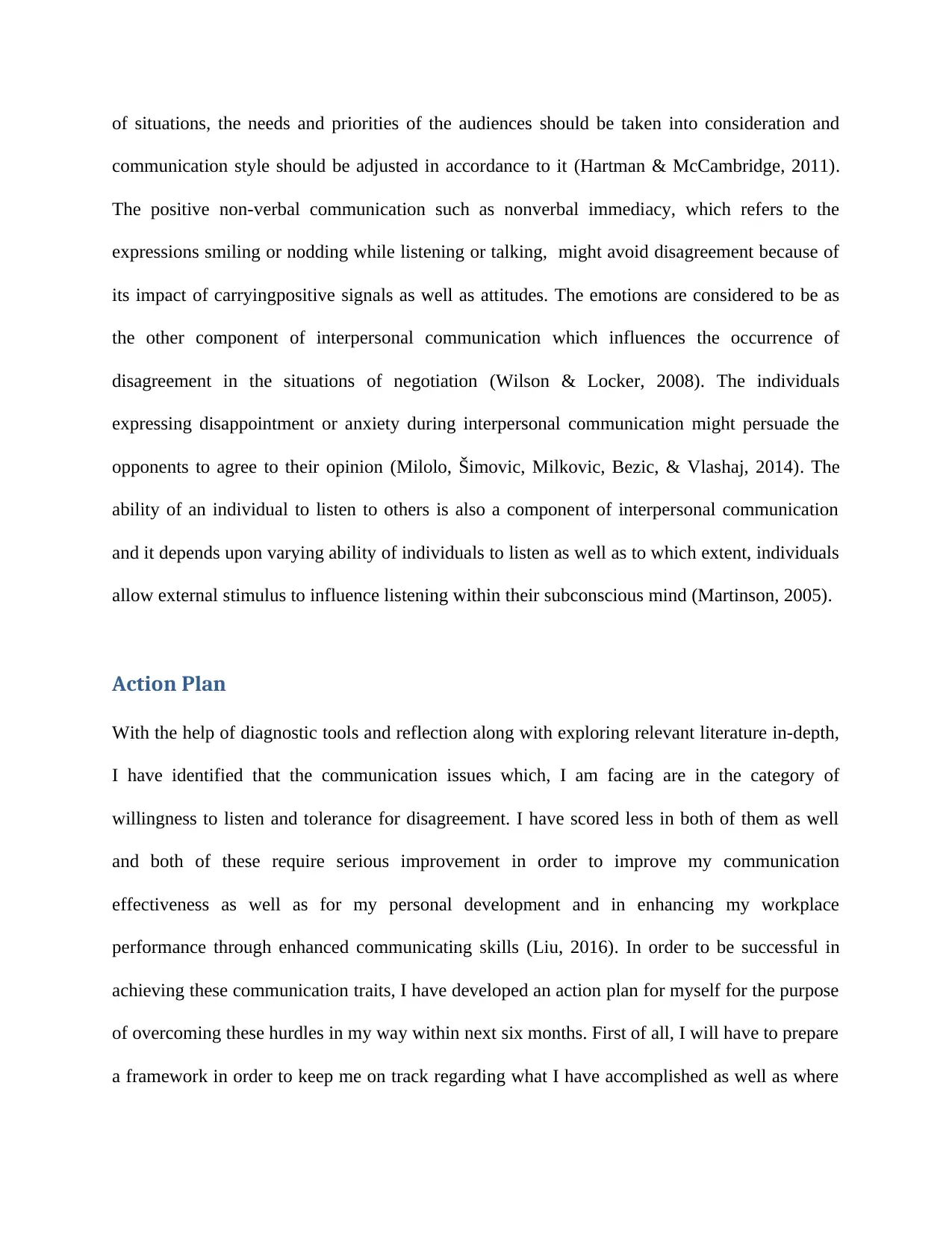
of situations, the needs and priorities of the audiences should be taken into consideration and
communication style should be adjusted in accordance to it (Hartman & McCambridge, 2011).
The positive non-verbal communication such as nonverbal immediacy, which refers to the
expressions smiling or nodding while listening or talking, might avoid disagreement because of
its impact of carryingpositive signals as well as attitudes. The emotions are considered to be as
the other component of interpersonal communication which influences the occurrence of
disagreement in the situations of negotiation (Wilson & Locker, 2008). The individuals
expressing disappointment or anxiety during interpersonal communication might persuade the
opponents to agree to their opinion (Milolo, Šimovic, Milkovic, Bezic, & Vlashaj, 2014). The
ability of an individual to listen to others is also a component of interpersonal communication
and it depends upon varying ability of individuals to listen as well as to which extent, individuals
allow external stimulus to influence listening within their subconscious mind (Martinson, 2005).
Action Plan
With the help of diagnostic tools and reflection along with exploring relevant literature in-depth,
I have identified that the communication issues which, I am facing are in the category of
willingness to listen and tolerance for disagreement. I have scored less in both of them as well
and both of these require serious improvement in order to improve my communication
effectiveness as well as for my personal development and in enhancing my workplace
performance through enhanced communicating skills (Liu, 2016). In order to be successful in
achieving these communication traits, I have developed an action plan for myself for the purpose
of overcoming these hurdles in my way within next six months. First of all, I will have to prepare
a framework in order to keep me on track regarding what I have accomplished as well as where
communication style should be adjusted in accordance to it (Hartman & McCambridge, 2011).
The positive non-verbal communication such as nonverbal immediacy, which refers to the
expressions smiling or nodding while listening or talking, might avoid disagreement because of
its impact of carryingpositive signals as well as attitudes. The emotions are considered to be as
the other component of interpersonal communication which influences the occurrence of
disagreement in the situations of negotiation (Wilson & Locker, 2008). The individuals
expressing disappointment or anxiety during interpersonal communication might persuade the
opponents to agree to their opinion (Milolo, Šimovic, Milkovic, Bezic, & Vlashaj, 2014). The
ability of an individual to listen to others is also a component of interpersonal communication
and it depends upon varying ability of individuals to listen as well as to which extent, individuals
allow external stimulus to influence listening within their subconscious mind (Martinson, 2005).
Action Plan
With the help of diagnostic tools and reflection along with exploring relevant literature in-depth,
I have identified that the communication issues which, I am facing are in the category of
willingness to listen and tolerance for disagreement. I have scored less in both of them as well
and both of these require serious improvement in order to improve my communication
effectiveness as well as for my personal development and in enhancing my workplace
performance through enhanced communicating skills (Liu, 2016). In order to be successful in
achieving these communication traits, I have developed an action plan for myself for the purpose
of overcoming these hurdles in my way within next six months. First of all, I will have to prepare
a framework in order to keep me on track regarding what I have accomplished as well as where

further progress is required. After the completion of period of six months, through structured
framework, I will be able to identify the areas, where I have improved and where I need to work
on to improvise. It will help me in planning for the future as well.
Secondly, I will take assistance from the mentor who will guide me on each and every step
towards improvisation. An expert mentor will direct and manage the overall process and I will
become able to overcome the communication issues related to less willingness to listen to others
and to be patient enough to listen and understand others. The mentor will make the overall
process highly effective and progressive towards improvising my communication skills. I will
take the assistance and coaching ofa highly expert coach Mr. Alex who is a certified coach and
has an experience of several years as a professional coach and has provided assistance to number
of people regarding various communication issues. I will have to do only one thing that is, to join
the 4 week training program being provided by the coach in which, he will train me how to
control my emotions and how to give heed to others and presenting myself with confidence in
collaboration with others. He will train me to work on team building and considering everyone
equal and significant particularly in the process of decision making.
According to Cocks, Moulton, Luu, and Cil (2014), mental practices and strategies have been
used successfully to improve performance of individuals based upon which, I will integrate
mental practices as well as strategies within my action plan in order to improve my ability to
listen to others and provide them equal heed during discussions or meetings. It will develop
healthy relationships with the team members and will enhance the overall performance of the
organization and personal development as well. It will reduce stress level as interpersonal
conflicts between me and team members will be resolved when I will provide them equal
consideration and include their opinions in the process of decision making.
framework, I will be able to identify the areas, where I have improved and where I need to work
on to improvise. It will help me in planning for the future as well.
Secondly, I will take assistance from the mentor who will guide me on each and every step
towards improvisation. An expert mentor will direct and manage the overall process and I will
become able to overcome the communication issues related to less willingness to listen to others
and to be patient enough to listen and understand others. The mentor will make the overall
process highly effective and progressive towards improvising my communication skills. I will
take the assistance and coaching ofa highly expert coach Mr. Alex who is a certified coach and
has an experience of several years as a professional coach and has provided assistance to number
of people regarding various communication issues. I will have to do only one thing that is, to join
the 4 week training program being provided by the coach in which, he will train me how to
control my emotions and how to give heed to others and presenting myself with confidence in
collaboration with others. He will train me to work on team building and considering everyone
equal and significant particularly in the process of decision making.
According to Cocks, Moulton, Luu, and Cil (2014), mental practices and strategies have been
used successfully to improve performance of individuals based upon which, I will integrate
mental practices as well as strategies within my action plan in order to improve my ability to
listen to others and provide them equal heed during discussions or meetings. It will develop
healthy relationships with the team members and will enhance the overall performance of the
organization and personal development as well. It will reduce stress level as interpersonal
conflicts between me and team members will be resolved when I will provide them equal
consideration and include their opinions in the process of decision making.
Secure Best Marks with AI Grader
Need help grading? Try our AI Grader for instant feedback on your assignments.
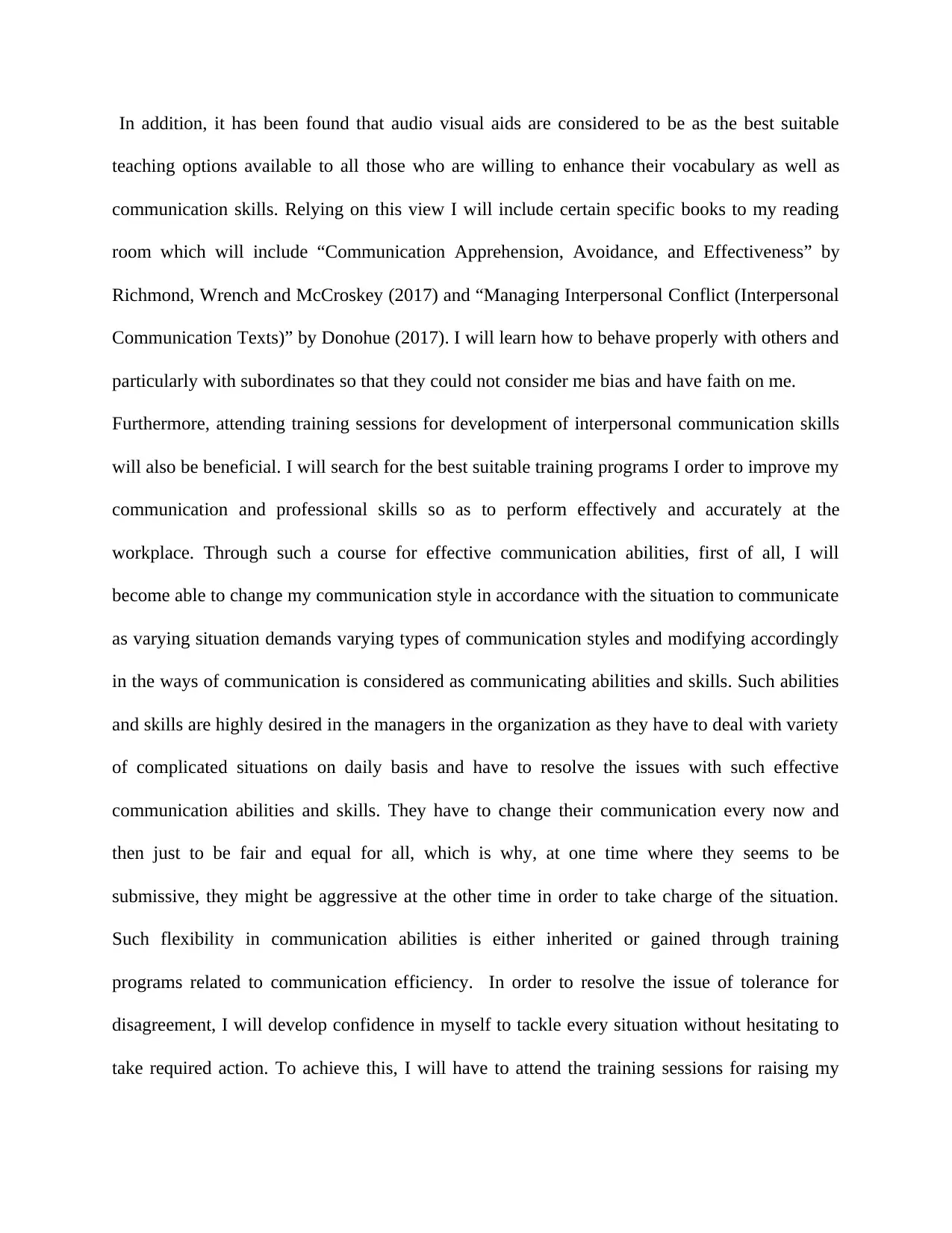
In addition, it has been found that audio visual aids are considered to be as the best suitable
teaching options available to all those who are willing to enhance their vocabulary as well as
communication skills. Relying on this view I will include certain specific books to my reading
room which will include “Communication Apprehension, Avoidance, and Effectiveness” by
Richmond, Wrench and McCroskey (2017) and “Managing Interpersonal Conflict (Interpersonal
Communication Texts)” by Donohue (2017). I will learn how to behave properly with others and
particularly with subordinates so that they could not consider me bias and have faith on me.
Furthermore, attending training sessions for development of interpersonal communication skills
will also be beneficial. I will search for the best suitable training programs I order to improve my
communication and professional skills so as to perform effectively and accurately at the
workplace. Through such a course for effective communication abilities, first of all, I will
become able to change my communication style in accordance with the situation to communicate
as varying situation demands varying types of communication styles and modifying accordingly
in the ways of communication is considered as communicating abilities and skills. Such abilities
and skills are highly desired in the managers in the organization as they have to deal with variety
of complicated situations on daily basis and have to resolve the issues with such effective
communication abilities and skills. They have to change their communication every now and
then just to be fair and equal for all, which is why, at one time where they seems to be
submissive, they might be aggressive at the other time in order to take charge of the situation.
Such flexibility in communication abilities is either inherited or gained through training
programs related to communication efficiency. In order to resolve the issue of tolerance for
disagreement, I will develop confidence in myself to tackle every situation without hesitating to
take required action. To achieve this, I will have to attend the training sessions for raising my
teaching options available to all those who are willing to enhance their vocabulary as well as
communication skills. Relying on this view I will include certain specific books to my reading
room which will include “Communication Apprehension, Avoidance, and Effectiveness” by
Richmond, Wrench and McCroskey (2017) and “Managing Interpersonal Conflict (Interpersonal
Communication Texts)” by Donohue (2017). I will learn how to behave properly with others and
particularly with subordinates so that they could not consider me bias and have faith on me.
Furthermore, attending training sessions for development of interpersonal communication skills
will also be beneficial. I will search for the best suitable training programs I order to improve my
communication and professional skills so as to perform effectively and accurately at the
workplace. Through such a course for effective communication abilities, first of all, I will
become able to change my communication style in accordance with the situation to communicate
as varying situation demands varying types of communication styles and modifying accordingly
in the ways of communication is considered as communicating abilities and skills. Such abilities
and skills are highly desired in the managers in the organization as they have to deal with variety
of complicated situations on daily basis and have to resolve the issues with such effective
communication abilities and skills. They have to change their communication every now and
then just to be fair and equal for all, which is why, at one time where they seems to be
submissive, they might be aggressive at the other time in order to take charge of the situation.
Such flexibility in communication abilities is either inherited or gained through training
programs related to communication efficiency. In order to resolve the issue of tolerance for
disagreement, I will develop confidence in myself to tackle every situation without hesitating to
take required action. To achieve this, I will have to attend the training sessions for raising my
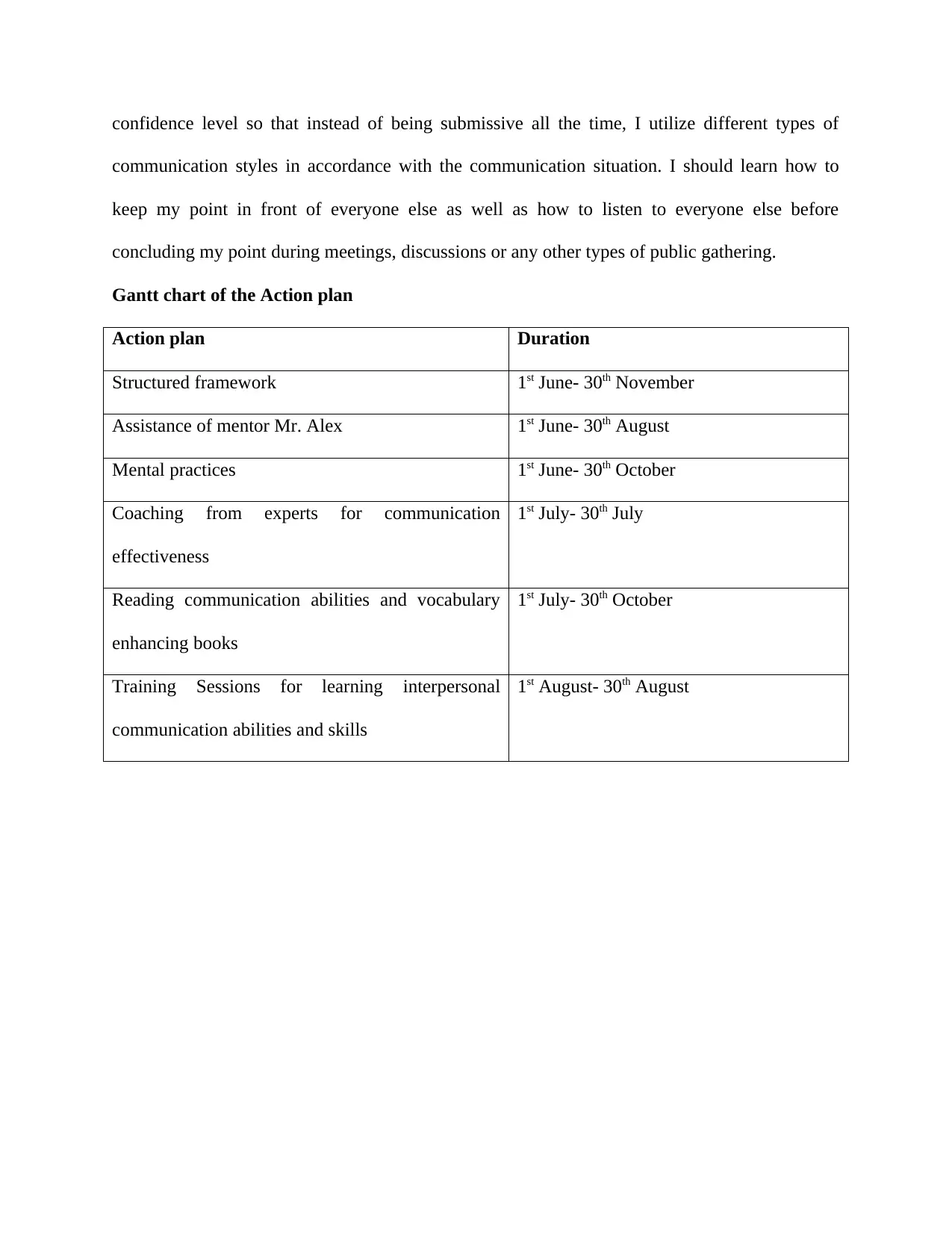
confidence level so that instead of being submissive all the time, I utilize different types of
communication styles in accordance with the communication situation. I should learn how to
keep my point in front of everyone else as well as how to listen to everyone else before
concluding my point during meetings, discussions or any other types of public gathering.
Gantt chart of the Action plan
Action plan Duration
Structured framework 1st June- 30th November
Assistance of mentor Mr. Alex 1st June- 30th August
Mental practices 1st June- 30th October
Coaching from experts for communication
effectiveness
1st July- 30th July
Reading communication abilities and vocabulary
enhancing books
1st July- 30th October
Training Sessions for learning interpersonal
communication abilities and skills
1st August- 30th August
communication styles in accordance with the communication situation. I should learn how to
keep my point in front of everyone else as well as how to listen to everyone else before
concluding my point during meetings, discussions or any other types of public gathering.
Gantt chart of the Action plan
Action plan Duration
Structured framework 1st June- 30th November
Assistance of mentor Mr. Alex 1st June- 30th August
Mental practices 1st June- 30th October
Coaching from experts for communication
effectiveness
1st July- 30th July
Reading communication abilities and vocabulary
enhancing books
1st July- 30th October
Training Sessions for learning interpersonal
communication abilities and skills
1st August- 30th August
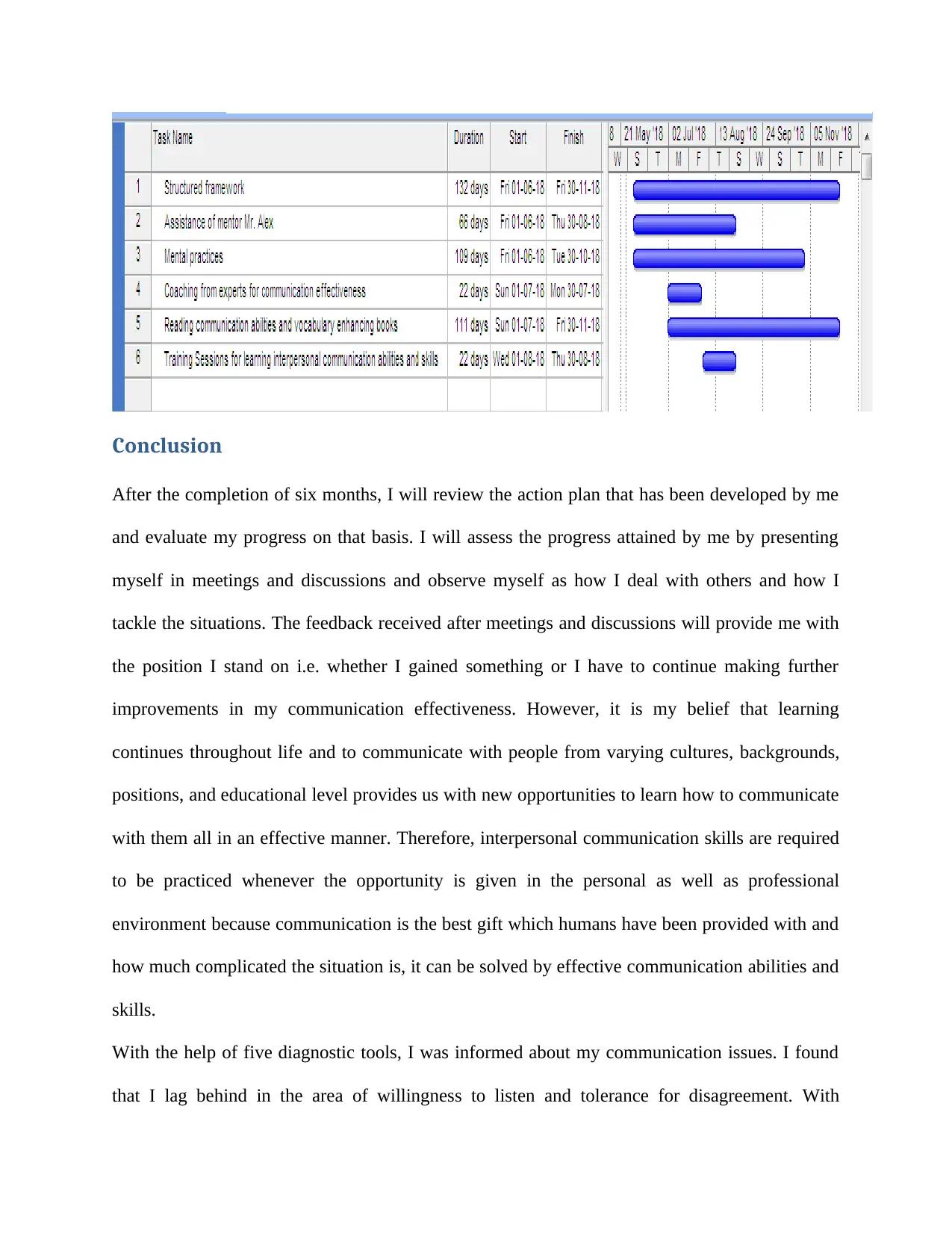
Conclusion
After the completion of six months, I will review the action plan that has been developed by me
and evaluate my progress on that basis. I will assess the progress attained by me by presenting
myself in meetings and discussions and observe myself as how I deal with others and how I
tackle the situations. The feedback received after meetings and discussions will provide me with
the position I stand on i.e. whether I gained something or I have to continue making further
improvements in my communication effectiveness. However, it is my belief that learning
continues throughout life and to communicate with people from varying cultures, backgrounds,
positions, and educational level provides us with new opportunities to learn how to communicate
with them all in an effective manner. Therefore, interpersonal communication skills are required
to be practiced whenever the opportunity is given in the personal as well as professional
environment because communication is the best gift which humans have been provided with and
how much complicated the situation is, it can be solved by effective communication abilities and
skills.
With the help of five diagnostic tools, I was informed about my communication issues. I found
that I lag behind in the area of willingness to listen and tolerance for disagreement. With
After the completion of six months, I will review the action plan that has been developed by me
and evaluate my progress on that basis. I will assess the progress attained by me by presenting
myself in meetings and discussions and observe myself as how I deal with others and how I
tackle the situations. The feedback received after meetings and discussions will provide me with
the position I stand on i.e. whether I gained something or I have to continue making further
improvements in my communication effectiveness. However, it is my belief that learning
continues throughout life and to communicate with people from varying cultures, backgrounds,
positions, and educational level provides us with new opportunities to learn how to communicate
with them all in an effective manner. Therefore, interpersonal communication skills are required
to be practiced whenever the opportunity is given in the personal as well as professional
environment because communication is the best gift which humans have been provided with and
how much complicated the situation is, it can be solved by effective communication abilities and
skills.
With the help of five diagnostic tools, I was informed about my communication issues. I found
that I lag behind in the area of willingness to listen and tolerance for disagreement. With
Paraphrase This Document
Need a fresh take? Get an instant paraphrase of this document with our AI Paraphraser
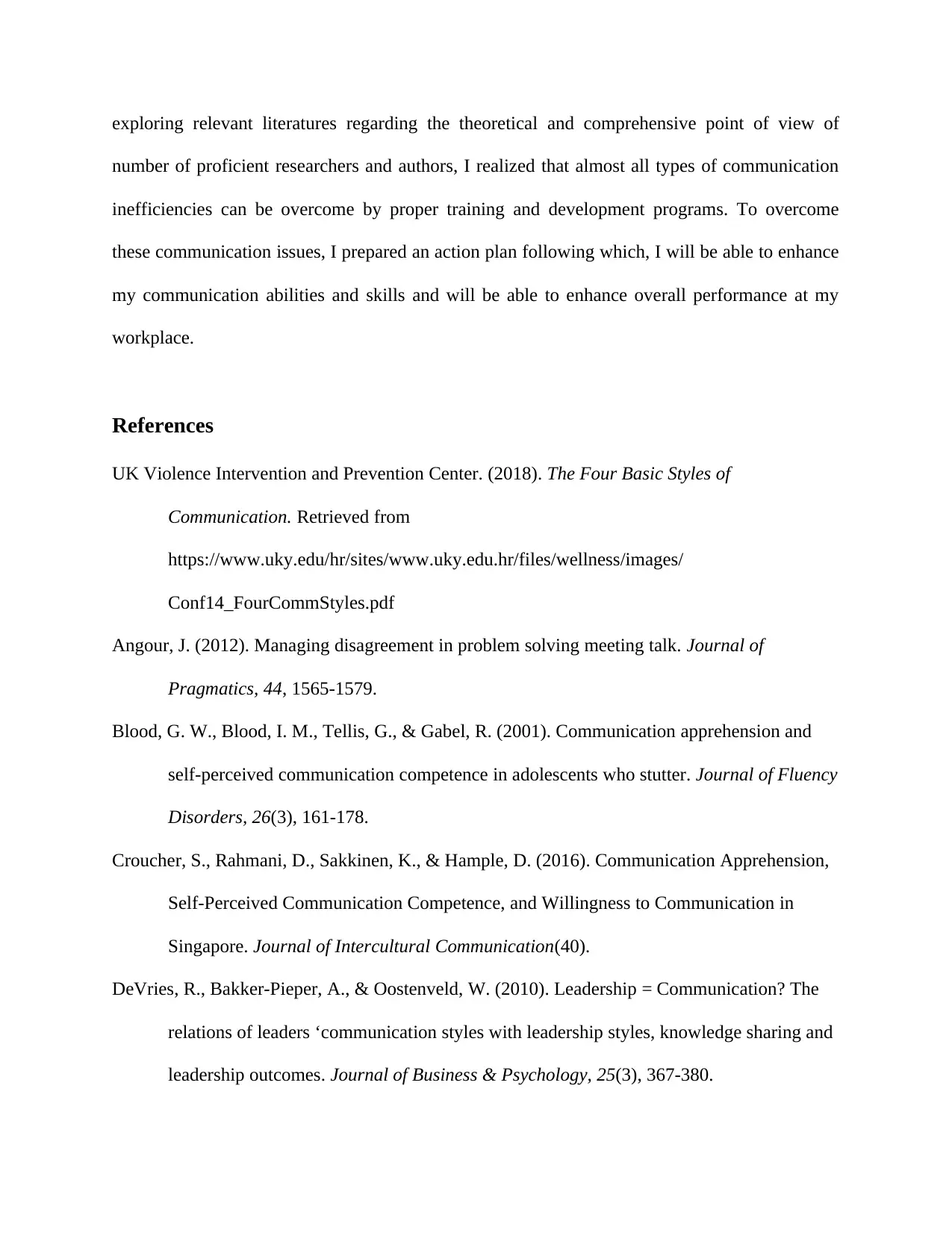
exploring relevant literatures regarding the theoretical and comprehensive point of view of
number of proficient researchers and authors, I realized that almost all types of communication
inefficiencies can be overcome by proper training and development programs. To overcome
these communication issues, I prepared an action plan following which, I will be able to enhance
my communication abilities and skills and will be able to enhance overall performance at my
workplace.
References
UK Violence Intervention and Prevention Center. (2018). The Four Basic Styles of
Communication. Retrieved from
https://www.uky.edu/hr/sites/www.uky.edu.hr/files/wellness/images/
Conf14_FourCommStyles.pdf
Angour, J. (2012). Managing disagreement in problem solving meeting talk. Journal of
Pragmatics, 44, 1565-1579.
Blood, G. W., Blood, I. M., Tellis, G., & Gabel, R. (2001). Communication apprehension and
self-perceived communication competence in adolescents who stutter. Journal of Fluency
Disorders, 26(3), 161-178.
Croucher, S., Rahmani, D., Sakkinen, K., & Hample, D. (2016). Communication Apprehension,
Self-Perceived Communication Competence, and Willingness to Communication in
Singapore. Journal of Intercultural Communication(40).
DeVries, R., Bakker-Pieper, A., & Oostenveld, W. (2010). Leadership = Communication? The
relations of leaders ‘communication styles with leadership styles, knowledge sharing and
leadership outcomes. Journal of Business & Psychology, 25(3), 367-380.
number of proficient researchers and authors, I realized that almost all types of communication
inefficiencies can be overcome by proper training and development programs. To overcome
these communication issues, I prepared an action plan following which, I will be able to enhance
my communication abilities and skills and will be able to enhance overall performance at my
workplace.
References
UK Violence Intervention and Prevention Center. (2018). The Four Basic Styles of
Communication. Retrieved from
https://www.uky.edu/hr/sites/www.uky.edu.hr/files/wellness/images/
Conf14_FourCommStyles.pdf
Angour, J. (2012). Managing disagreement in problem solving meeting talk. Journal of
Pragmatics, 44, 1565-1579.
Blood, G. W., Blood, I. M., Tellis, G., & Gabel, R. (2001). Communication apprehension and
self-perceived communication competence in adolescents who stutter. Journal of Fluency
Disorders, 26(3), 161-178.
Croucher, S., Rahmani, D., Sakkinen, K., & Hample, D. (2016). Communication Apprehension,
Self-Perceived Communication Competence, and Willingness to Communication in
Singapore. Journal of Intercultural Communication(40).
DeVries, R., Bakker-Pieper, A., & Oostenveld, W. (2010). Leadership = Communication? The
relations of leaders ‘communication styles with leadership styles, knowledge sharing and
leadership outcomes. Journal of Business & Psychology, 25(3), 367-380.
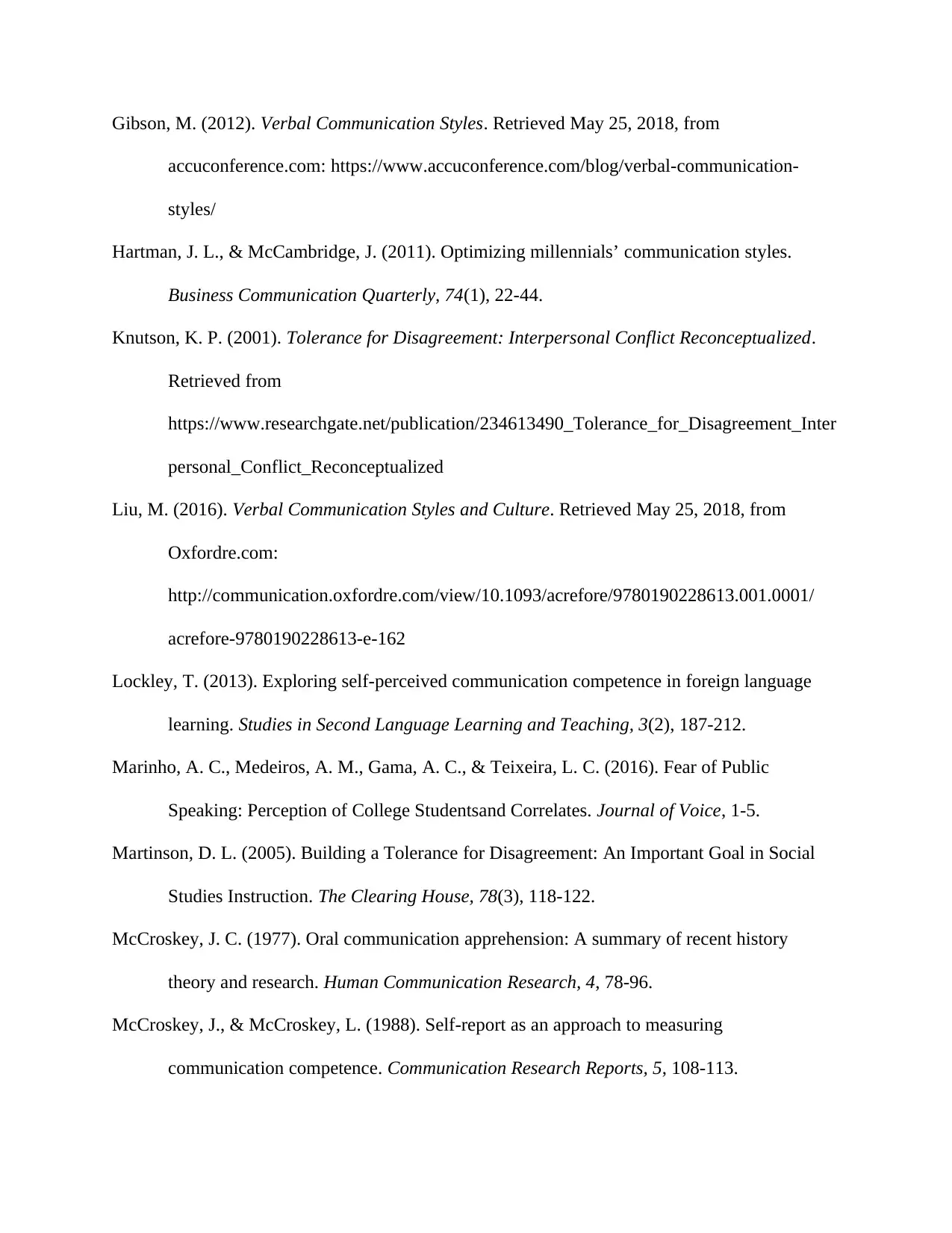
Gibson, M. (2012). Verbal Communication Styles. Retrieved May 25, 2018, from
accuconference.com: https://www.accuconference.com/blog/verbal-communication-
styles/
Hartman, J. L., & McCambridge, J. (2011). Optimizing millennials’ communication styles.
Business Communication Quarterly, 74(1), 22-44.
Knutson, K. P. (2001). Tolerance for Disagreement: Interpersonal Conflict Reconceptualized.
Retrieved from
https://www.researchgate.net/publication/234613490_Tolerance_for_Disagreement_Inter
personal_Conflict_Reconceptualized
Liu, M. (2016). Verbal Communication Styles and Culture. Retrieved May 25, 2018, from
Oxfordre.com:
http://communication.oxfordre.com/view/10.1093/acrefore/9780190228613.001.0001/
acrefore-9780190228613-e-162
Lockley, T. (2013). Exploring self-perceived communication competence in foreign language
learning. Studies in Second Language Learning and Teaching, 3(2), 187-212.
Marinho, A. C., Medeiros, A. M., Gama, A. C., & Teixeira, L. C. (2016). Fear of Public
Speaking: Perception of College Studentsand Correlates. Journal of Voice, 1-5.
Martinson, D. L. (2005). Building a Tolerance for Disagreement: An Important Goal in Social
Studies Instruction. The Clearing House, 78(3), 118-122.
McCroskey, J. C. (1977). Oral communication apprehension: A summary of recent history
theory and research. Human Communication Research, 4, 78-96.
McCroskey, J., & McCroskey, L. (1988). Self-report as an approach to measuring
communication competence. Communication Research Reports, 5, 108-113.
accuconference.com: https://www.accuconference.com/blog/verbal-communication-
styles/
Hartman, J. L., & McCambridge, J. (2011). Optimizing millennials’ communication styles.
Business Communication Quarterly, 74(1), 22-44.
Knutson, K. P. (2001). Tolerance for Disagreement: Interpersonal Conflict Reconceptualized.
Retrieved from
https://www.researchgate.net/publication/234613490_Tolerance_for_Disagreement_Inter
personal_Conflict_Reconceptualized
Liu, M. (2016). Verbal Communication Styles and Culture. Retrieved May 25, 2018, from
Oxfordre.com:
http://communication.oxfordre.com/view/10.1093/acrefore/9780190228613.001.0001/
acrefore-9780190228613-e-162
Lockley, T. (2013). Exploring self-perceived communication competence in foreign language
learning. Studies in Second Language Learning and Teaching, 3(2), 187-212.
Marinho, A. C., Medeiros, A. M., Gama, A. C., & Teixeira, L. C. (2016). Fear of Public
Speaking: Perception of College Studentsand Correlates. Journal of Voice, 1-5.
Martinson, D. L. (2005). Building a Tolerance for Disagreement: An Important Goal in Social
Studies Instruction. The Clearing House, 78(3), 118-122.
McCroskey, J. C. (1977). Oral communication apprehension: A summary of recent history
theory and research. Human Communication Research, 4, 78-96.
McCroskey, J., & McCroskey, L. (1988). Self-report as an approach to measuring
communication competence. Communication Research Reports, 5, 108-113.
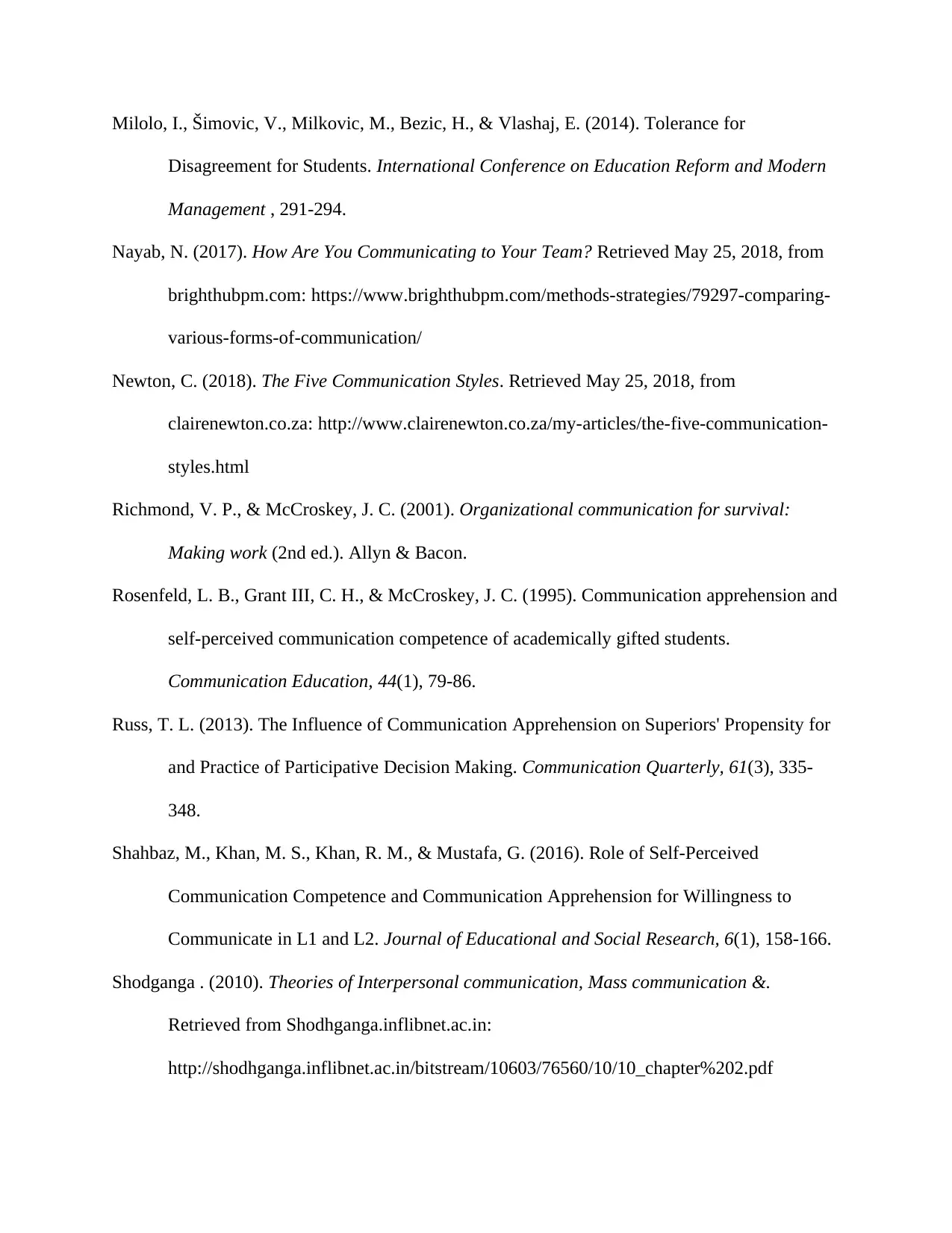
Milolo, I., Šimovic, V., Milkovic, M., Bezic, H., & Vlashaj, E. (2014). Tolerance for
Disagreement for Students. International Conference on Education Reform and Modern
Management , 291-294.
Nayab, N. (2017). How Are You Communicating to Your Team? Retrieved May 25, 2018, from
brighthubpm.com: https://www.brighthubpm.com/methods-strategies/79297-comparing-
various-forms-of-communication/
Newton, C. (2018). The Five Communication Styles. Retrieved May 25, 2018, from
clairenewton.co.za: http://www.clairenewton.co.za/my-articles/the-five-communication-
styles.html
Richmond, V. P., & McCroskey, J. C. (2001). Organizational communication for survival:
Making work (2nd ed.). Allyn & Bacon.
Rosenfeld, L. B., Grant III, C. H., & McCroskey, J. C. (1995). Communication apprehension and
self-perceived communication competence of academically gifted students.
Communication Education, 44(1), 79-86.
Russ, T. L. (2013). The Influence of Communication Apprehension on Superiors' Propensity for
and Practice of Participative Decision Making. Communication Quarterly, 61(3), 335-
348.
Shahbaz, M., Khan, M. S., Khan, R. M., & Mustafa, G. (2016). Role of Self-Perceived
Communication Competence and Communication Apprehension for Willingness to
Communicate in L1 and L2. Journal of Educational and Social Research, 6(1), 158-166.
Shodganga . (2010). Theories of Interpersonal communication, Mass communication &.
Retrieved from Shodhganga.inflibnet.ac.in:
http://shodhganga.inflibnet.ac.in/bitstream/10603/76560/10/10_chapter%202.pdf
Disagreement for Students. International Conference on Education Reform and Modern
Management , 291-294.
Nayab, N. (2017). How Are You Communicating to Your Team? Retrieved May 25, 2018, from
brighthubpm.com: https://www.brighthubpm.com/methods-strategies/79297-comparing-
various-forms-of-communication/
Newton, C. (2018). The Five Communication Styles. Retrieved May 25, 2018, from
clairenewton.co.za: http://www.clairenewton.co.za/my-articles/the-five-communication-
styles.html
Richmond, V. P., & McCroskey, J. C. (2001). Organizational communication for survival:
Making work (2nd ed.). Allyn & Bacon.
Rosenfeld, L. B., Grant III, C. H., & McCroskey, J. C. (1995). Communication apprehension and
self-perceived communication competence of academically gifted students.
Communication Education, 44(1), 79-86.
Russ, T. L. (2013). The Influence of Communication Apprehension on Superiors' Propensity for
and Practice of Participative Decision Making. Communication Quarterly, 61(3), 335-
348.
Shahbaz, M., Khan, M. S., Khan, R. M., & Mustafa, G. (2016). Role of Self-Perceived
Communication Competence and Communication Apprehension for Willingness to
Communicate in L1 and L2. Journal of Educational and Social Research, 6(1), 158-166.
Shodganga . (2010). Theories of Interpersonal communication, Mass communication &.
Retrieved from Shodhganga.inflibnet.ac.in:
http://shodhganga.inflibnet.ac.in/bitstream/10603/76560/10/10_chapter%202.pdf
Secure Best Marks with AI Grader
Need help grading? Try our AI Grader for instant feedback on your assignments.
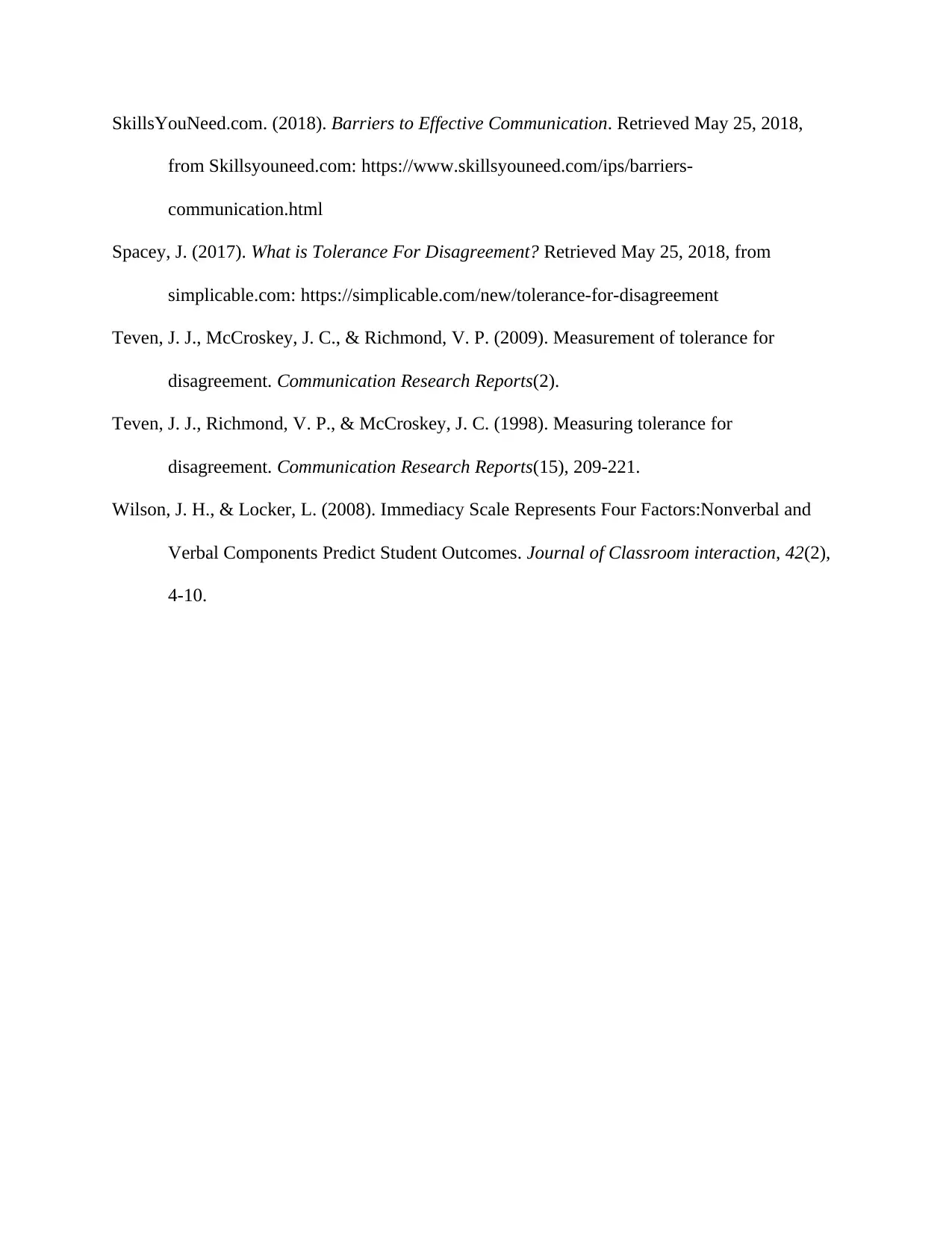
SkillsYouNeed.com. (2018). Barriers to Effective Communication. Retrieved May 25, 2018,
from Skillsyouneed.com: https://www.skillsyouneed.com/ips/barriers-
communication.html
Spacey, J. (2017). What is Tolerance For Disagreement? Retrieved May 25, 2018, from
simplicable.com: https://simplicable.com/new/tolerance-for-disagreement
Teven, J. J., McCroskey, J. C., & Richmond, V. P. (2009). Measurement of tolerance for
disagreement. Communication Research Reports(2).
Teven, J. J., Richmond, V. P., & McCroskey, J. C. (1998). Measuring tolerance for
disagreement. Communication Research Reports(15), 209-221.
Wilson, J. H., & Locker, L. (2008). Immediacy Scale Represents Four Factors:Nonverbal and
Verbal Components Predict Student Outcomes. Journal of Classroom interaction, 42(2),
4-10.
from Skillsyouneed.com: https://www.skillsyouneed.com/ips/barriers-
communication.html
Spacey, J. (2017). What is Tolerance For Disagreement? Retrieved May 25, 2018, from
simplicable.com: https://simplicable.com/new/tolerance-for-disagreement
Teven, J. J., McCroskey, J. C., & Richmond, V. P. (2009). Measurement of tolerance for
disagreement. Communication Research Reports(2).
Teven, J. J., Richmond, V. P., & McCroskey, J. C. (1998). Measuring tolerance for
disagreement. Communication Research Reports(15), 209-221.
Wilson, J. H., & Locker, L. (2008). Immediacy Scale Represents Four Factors:Nonverbal and
Verbal Components Predict Student Outcomes. Journal of Classroom interaction, 42(2),
4-10.
1 out of 17
Related Documents
Your All-in-One AI-Powered Toolkit for Academic Success.
+13062052269
info@desklib.com
Available 24*7 on WhatsApp / Email
![[object Object]](/_next/static/media/star-bottom.7253800d.svg)
Unlock your academic potential
© 2024 | Zucol Services PVT LTD | All rights reserved.


